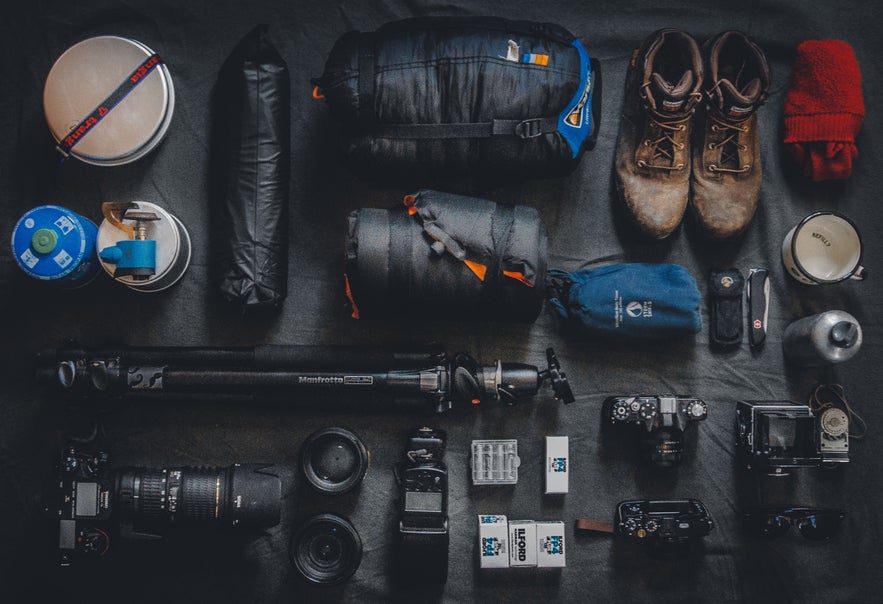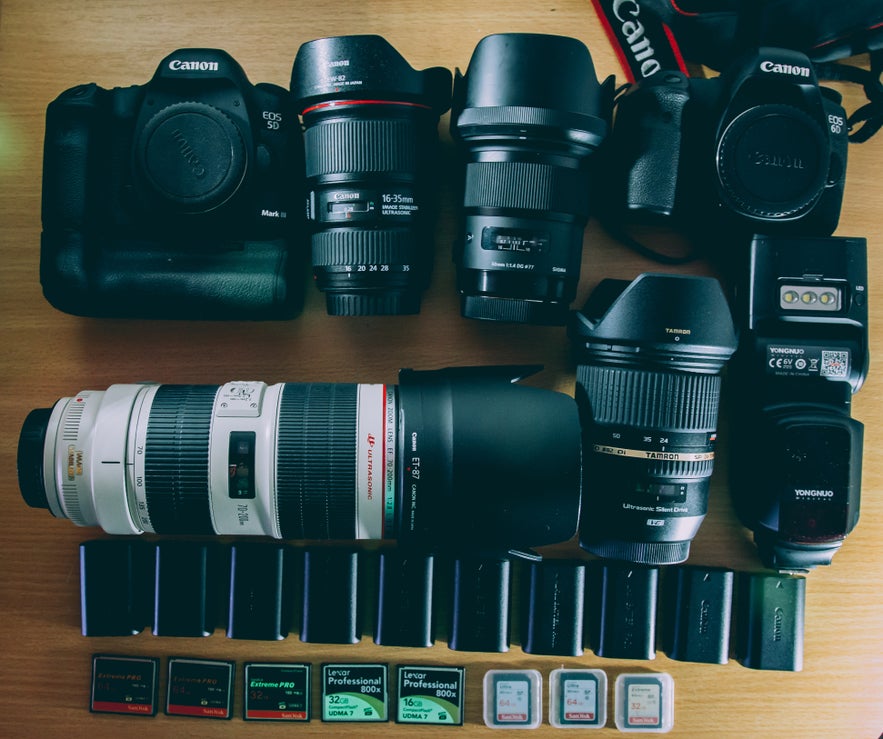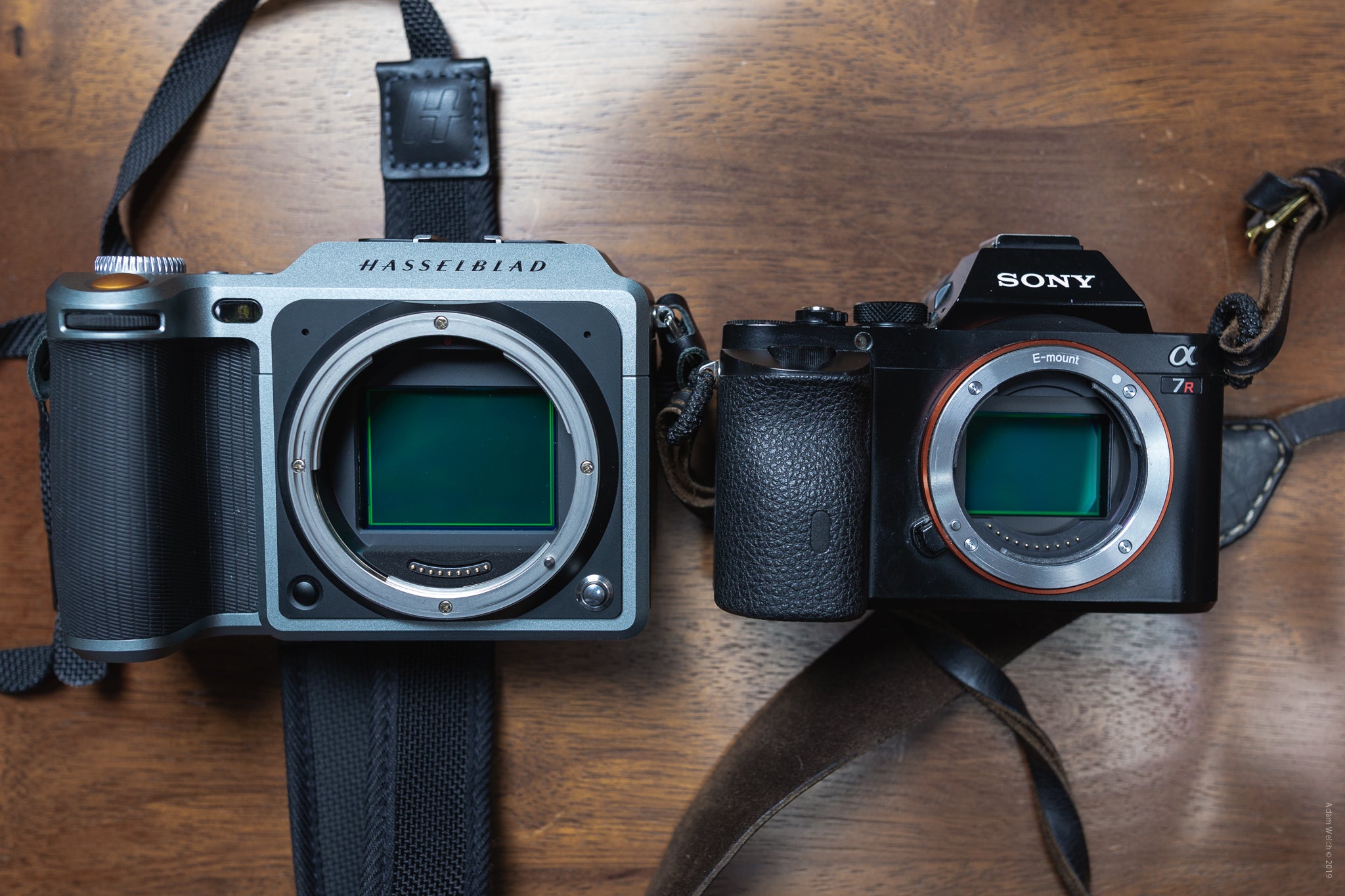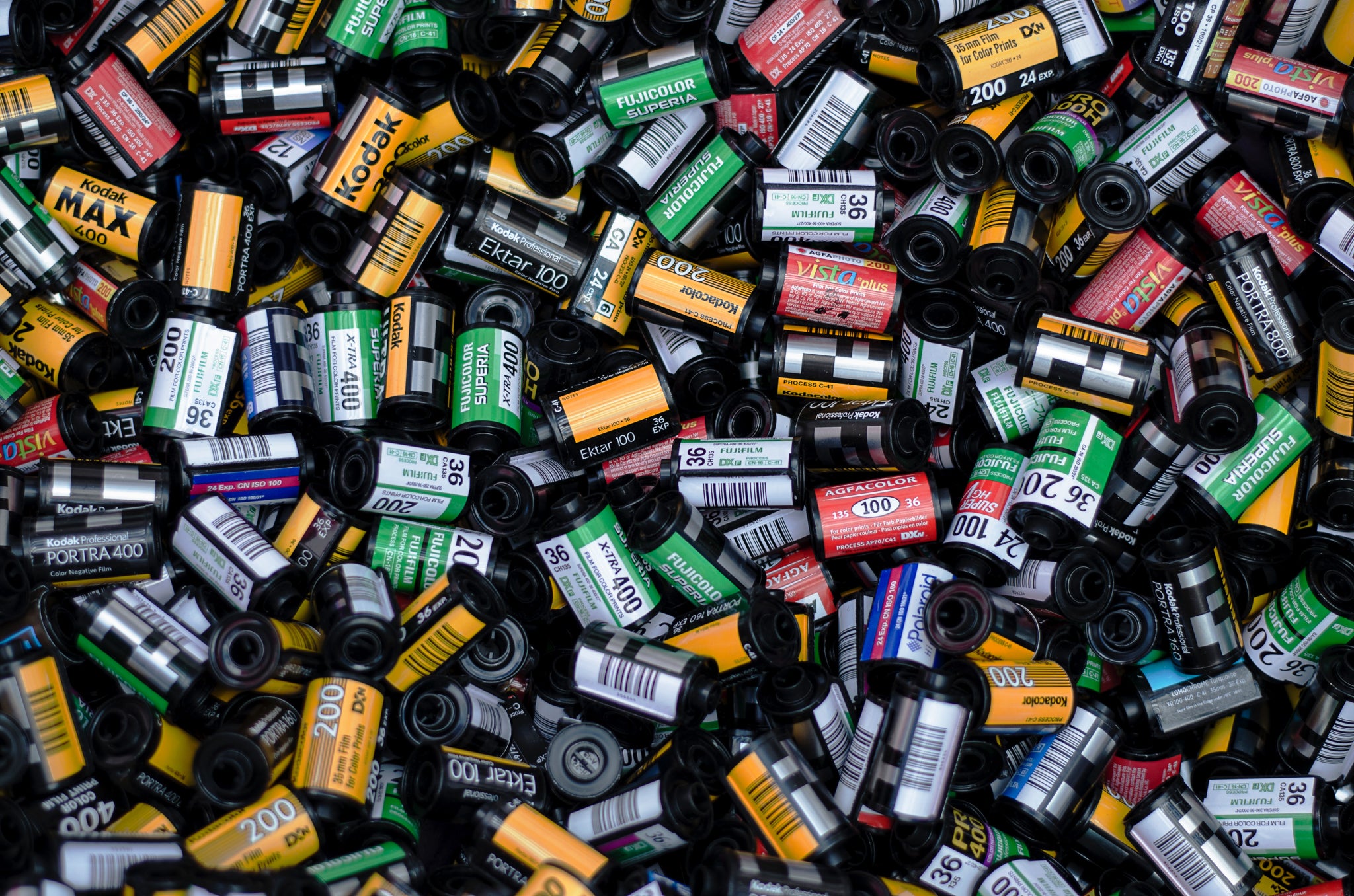
Once you have your camera and lens, it is time to look into the DSLR accessories that will aid you most with your photography. Whether you are turning your eye towards street, portrait or landscape photography, here are a few items that will range from helpful to essential.
- Check out these Camera & Gear Reviews
- Join us on this 11 Day Northern Lights Photo Workshop around Iceland
Some of these DSLR accessories are specific to your camera make and model. Make sure that you research before you buy, in order to ensure that these items will work with your DSLR camera system.
 A DSLR is a very powerful camera to use. Photo by: 'Jakob Owens'.
A DSLR is a very powerful camera to use. Photo by: 'Jakob Owens'.
- See also: The Ultimate Guide to Drone Travel Gear
#15. Head Lamp
Night photography shoots are fun for capturing the Milky Way, star trails and anything in the big sky above you. The problem with nighttime though is the darkness. The last thing you want to do is to set up your gear without light. You’re more likely to fumble around and to damage your equipment.
A headlamp is one of those DSLR accessories you won’t need all the time but when the sun goes down, you’ll be happy to have one. It fits over your head, keeping both your hands free to find and set up your gear.
If night photography is something you want to get into, then choose a headlamp with a red light. This light is softer on the eyes and helps you to acclimatise to the darkest of nights. Unlike white light, the red light will not ruin your image with additional light.
 Nighttime shots can benefit from the use of a headlamp. Photo by: 'Matt Gross'.
Nighttime shots can benefit from the use of a headlamp. Photo by: 'Matt Gross'.
In addition to allowing you to see in the dark, you can also use a head lamp to light up objects and structures during long exposures.
- See also: Best Lenses for Night Photography
#14. 18% Grey Card
Each lighting source that you use will add different colour temperatures to your images. This can be great in some circumstances, though most photographers will want to keep their whites ‘white’.
A grey card helps the photographer set a correct white balance. A consistent colour cast will save precious time when editing your images later on.
 A grey card will help you find the correct white balance in your scene. Photo by: 'Foto-dus, Wikimedia Commons'.
A grey card will help you find the correct white balance in your scene. Photo by: 'Foto-dus, Wikimedia Commons'.
Grey cards are set at 18% grey, which sits between the darkest shadows and the lightest highlights. So how can grey help with the white balance? It sounds counterintuitive, yet this neutral grey reflects all colours, allowing the user to replicate the true colours in the scene.
A grey card is one of the cheapest DSLR accessories that you can buy but it will have the biggest impact on your photography. Double win!
#13. Rain Cover
With more advanced materials and technology these days, we are seeing more and more lenses and camera systems that are weatherproof. This isn’t the same as waterproof, as more than a spot of rain will damage your gear. Not only will this result in costly repairs but you’ll also miss out on a great photo session.
For heavy rain, you’ll need something else to protect your camera and lenses. A rain cover provides you with peace of mind. It will be one of the only DSLR accessories that will protect your gear, allowing you to get the best out of challenging situations.
#12. Mini Spirit Level
Landscape photography is a passion of mine, yet I have always found it difficult to keep the horizon straight. Correcting the image through rotation in editing software can cut out important parts of the scene which might otherwise be essential in bringing the entire scene together.
 A mini spirit level can help keep your camera and horizon straight. Photo by: 'Phil Sangwell, Wikimedia Commons'.
A mini spirit level can help keep your camera and horizon straight. Photo by: 'Phil Sangwell, Wikimedia Commons'.
A mini spirit level is essential in helping you to keep your scene straight. Your eyes can play tricks on you, especially when viewing the scene through the viewfinder or LCD screen. This piece of kit tells you when your scene is level, making the editing process easier and faster.
These DSLR accessories slip on to your camera’s cold/hot shoe and come with up to three levels, which help keep your panoramic landscape photography as flat as you find it.
#11. Remote Trigger
A remote trigger allows you to capture scenes without having to keep your finger on the shutter release. Some exposures can take minutes and even hours, forcing you to stand uncomfortably next to your gear. With a remote shutter button, you can set up your equipment, and sit down as you wait for the elements in your scene to align.
 A remote trigger allows you to step away from your camera and still control the shutter. Photo by: 'Alberto.iglesias01, Wikimedia Commons'.
A remote trigger allows you to step away from your camera and still control the shutter. Photo by: 'Alberto.iglesias01, Wikimedia Commons'.
Whether you are taking a picture of the sunset or a moving subject passing through your scene, using a remote trigger means that you can even sit down and sip hot cocoa while you wait. This is especially helpful if you have multiple cameras shooting a scene from many different perspectives and angles, such as with time lapse photography.
I use mine for long exposure landscape photography. It means that I can set up my camera, sit down and time an exposure more comfortably.
#10. External Flash
An external flash is one camera gear item that many photographers tend to steer away from. Lighting may seem to be a very difficult part of photography but all you need to master it is a bit of research, knowledge and practise. With a little patience, this could be the best DSLR camera accessory you could own. For fields such as portrait photography or event photography, an external flash is an essential piece of equipment.
 A flash is a great way to boost the light in your scene. Photo by: 'Luciano Zanollo'.
A flash is a great way to boost the light in your scene. Photo by: 'Luciano Zanollo'.
An external flash is a professional version of the on-camera flash that some DSLR cameras come equipped with. A flash unit sits on your camera’s hot shoe, where the camera and flash are free to communicate electronically. External flashes help to add light in poorly lit areas but also freeze any moving elements in your scene. Luckily, you can find a perfectly good flash online that will not break the bank.
#9. Camera Strap
For those of you who don’t need to carry a lot of equipment, having a camera bag on your shoulders can be frustrating. Handholding your DSLR camera keeps it ready to go at a moment's notice, though it can get tiring very quickly. You won’t find any security either with this method.
A strap is a great way to keep your camera close for when you need it whilst providing you with a necessary deterrent for thieves. As the camera is attached to your body, your camera gear will be less attractive to people aiming to do a grab-and-run with your items.
 A camera strap is a great way to ensure your camera is close for when you need it. Photo by: 'Ivana Cajina'.
A camera strap is a great way to ensure your camera is close for when you need it. Photo by: 'Ivana Cajina'.
The main purpose of a camera strap is to help distribute the weight of your gear and allow your hands to be free to use when you need them. A sturdy and reliable camera strap is one of the necessary DSLR accessories that you just can’t do without. I recommend the Peak Design slide, as it is comfortable whilst being quick and easy to adjust with one hand.
#8. Polarising Filter
If you’re big into architecture or landscape photography, then you may find that reflections from surfaces such as glass or water can minimise the powerfulness of your scene. These elements are not easily removed during post-processing.
The answer to controlling environmental glare is to use a polarising filter. These glass DSLR accessories fit on the front of your lens and reduce the amount of light that enters your DSLR camera. By turning the filter, you will have control of how the light passes through it. Less shiny surfaces will result in better quality images.
 Polarising filters reduce the glare that light in your scene can present. Photo by: 'Unsplash'.
Polarising filters reduce the glare that light in your scene can present. Photo by: 'Unsplash'.
With this DSLR accessory, you can even capture scenes behind glass and through shallow depths of water. Without a polarising filter, you'll simply see a glassy reflection instead.
For all choices in filters, we recommend NiSi. Their accessories are of a high-quality glass that will help you shoot the best shot possible.
#7. Tripod
Using a tripod is essential to stabilise your camera and lens system while shooting. Tripods are especially handy when shooting in windy conditions, or when trying popular photography techniques such as long exposures. They are also necessary for creating time-lapse videos.
If your photography session requires that your camera stays still in one place, then you’ll need a tripod. It will allow you to shoot the same perspective time and time again. The other benefit is that you can leave your camera on the tripod, knowing it is safe and secure.
 Tripods help to stabilise your camera, allowing you to capture a sharp image. Photo by: 'Nathan Anderson'.
Tripods help to stabilise your camera, allowing you to capture a sharp image. Photo by: 'Nathan Anderson'.
We recommend Gitzo tripods. What we like about them is their huge range, including lighter versions for travelling and heavier models for closer-to-home landscape photography. These tripods allow you to change the heads, giving you full control of how you move and position your DSLR.
- See also: The Best Tripods for Photography in 2020
#6. Lens Hood
Lens hoods tend to come with the lens you buy. You might miss out when you buy a lens second hand but lens hoods may be easily found online. These DSLR accessories are often overlooked and deemed unnecessary but they provide important benefits to your photography.
Firstly, a lens hood helps to reduce the direct light hitting the glass elements in your lens. Lens flares are created from direct sunlight hitting the glass in your lens, which is reflected onto your sensor and into the captured image.
 Lens hoods stop the direct sun from creating unwanted lens flares. Photo by: 'Oscar Ivan Esquivel Arteaga'.
Lens hoods stop the direct sun from creating unwanted lens flares. Photo by: 'Oscar Ivan Esquivel Arteaga'.
A lens hood also protects your lens from bumps and scrapes. If you prefer to handhold your camera or place it on a belt or strap, then your camera will be prone to damage. A lens hood protects the front element of your lens, preventing any expensive damage from occurring.
#5. Camera Bag
A camera bag is a very important DSLR accessory for many reasons. Firstly, it allows you to move around without showing the world the expensive gear that you are carrying with you. Second of all, a bag keeps all your devices and cables together, protecting them from damage and adverse weather conditions.
In a pinch, a camera bag can also act as a stabiliser. Placing your camera on your bag rather than on the ground or wall will reduce scrapes. This is especially handy when a tripod isn't available.
 A camera bag keeps your equipment together and by your side. Photo by: 'Matthieu Joannon'.
A camera bag keeps your equipment together and by your side. Photo by: 'Matthieu Joannon'.
The style of bag you choose will depend on your equipment and where you plan on shooting. Landscape photographers might prefer lots of pockets for extra DSLR accessories, so a waterproof backpack is advisable. Those who prefer to keep their kit to a minimum will benefit more from a sling bag.
- See also: The Best Camera Bags for 2020
#4. Cleaning Kit
Keeping your camera clean can be a challenge, especially if you use it daily. With use, your camera will pick up dust and dirt from the environment around it. Even when cautious, changing lenses will expose the mirror and interior of your equipment. These little particles will show in your captured scenes, forcing extra time and energy during the editing process.
 Keep your camera dust free with a cleaning kit. Photo by: 'Piqsels'.
Keep your camera dust free with a cleaning kit. Photo by: 'Piqsels'.
A good cleaning kit will include the items needed to keep electronic contacts and important areas clean of dust. I advise a kit that includes a microfibre cloth for polishing glass and a blaster to remove dust from your mirror. Cleaning liquids can also help the glass elements of your camera and lenses stay dirt free.
#3. Extra Batteries
A DSLR battery can last anywhere between a few hours and a few days. It all depends on how much you use your camera and built-in flash. Burst mode shooting and constant LCD screen usage demand precious battery power.
One battery is good for a short period but you’ll need to wait a few hours for the battery to fully charge. Why wait when you can take two or three with you just in case one doesn’t work?
 Extra batteries allows you to stay out and shoot more. Photo by: 'Ramiz Dedakovic'.
Extra batteries allows you to stay out and shoot more. Photo by: 'Ramiz Dedakovic'.
Extra batteries are necessary DSLR accessories that will allow you to shoot longer before needing to head home.
#2. Memory Card Holder
A memory card holder keeps your memory cards together in one place where they can stay protected from dust and adverse weather. CompactFlash (CF) and Secure Digital (SD) cards are small items, so a memory card case will stop them from getting lost or damaged.
These cases are small enough to place in your pocket, keeping them close when you need them. Some versions are brightly coloured, while others will float if dropped in water. Some of these DSLR accessories also hold spare batteries in the same space, reducing the need for extra holders.
Ensure you choose a memory card holder that favours the type of memory cards your camera and devices use.
#1. Memory Cards
Without a memory card, your DSLR camera may as well be an expensive paperweight. The memory card is the recording device of all digital cameras which allows you to store the images that you capture.
There are two main styles of memory card, Secure Digital (SD) and CompactFlash (CF). Check with your camera’s specifications on which type you’ll need. CF cards are mainly used by DSLRs, yet some cameras, such as the Canon EOS 5D Mark IV uses both SD and CF in their dual card slots.
 Memory cards allow you to capture the scene in front of you. Photo by: 'Bengt Nyman, Flickr Creative Commons'.
Memory cards allow you to capture the scene in front of you. Photo by: 'Bengt Nyman, Flickr Creative Commons'.
Memory cards come in different sizes and speeds. The size relates to how many images you can store on each card and the speed is the rate at which your card can process each image.
If you plan on shooting a lot of images in a short space of time, then you’ll need a faster speed card. Memory cards with large amounts of space allow you to capture more shots before heading home. For peace of mind, have back-ups as a safety measure.
About the author: Craig Hull is a freelance photographer and videographer based in Eastern Europe. You can find more of his work on his website or by following him on Facebook and Twitter.
Are there any other DSLR photography accessories that we haven't mentioned which you feel are necessary to have in your kit? Share your thoughts by leaving a comment below!











